Preliminary Validation of Surface Reflections from Fengyun-3C Radio Occultation Data
Abstract
1. Introduction
2. Data and Quality Control
2.1. COSMIC RO Data
2.2. FY-3C RO Data
2.3. Data Matching and Quality Control
3. Methods and Results
3.1. Comparison of FY-3C Refractivity Profiles with COSMIC
3.2. FY-3C Radio Holographic Analysis
3.3. Reflected Bending Angle Model of FY-3C
4. Discussion
5. Conclusions
Author Contributions
Funding
Institutional Review Board Statement
Informed Consent Statement
Acknowledgments
Conflicts of Interest
References
- Melbourne, W.; Davis, E.; Duncan, C.; Hajj, G.; Hardy, K.; Kursinski, E.; Meehan, T.; Young, L.; Yunck, T. The application of spaceborne GPS to atmospheric limb sounding and global change monitoring. JPL Publ. 1994, 147, 94-18. [Google Scholar]
- Kursinski, E.R.; Hajj, G.A.; Schofield, J.T.; Linfield, R.P.; Hardy, K.R. Observing Earth’s atmosphere with radio occultation measurements using the Global Positioning System. J. Geophys. Res. Atmos. 1997, 102, 23429–23465. [Google Scholar] [CrossRef]
- Kuo, Y.-H.; Zou, X.; Huang, W. The impact of global positioning system data on the prediction of an extratropical cyclone: An observing system simulation experiment. Dyn. Atmos. Ocean. 1998, 27, 439–470. [Google Scholar] [CrossRef]
- Kuo, Y.-H.; Zou, X.; Chen, S.; Huang, W.; Guo, Y.-R.; Anthes, R.; Exner, M.; Hunt, D.; Rocken, C.; Sokolovskiy, S. A GPS/MET sounding through an intense upper-level front. Bull. Am. Meteorol. Soc. 1998, 79, 617–626. [Google Scholar] [CrossRef]
- Barnes, D. GPS status and modernization. In Proceedings of the Presentation at Munich Satellite Navigation Summit 2019, Munich, Germany, 25–27 March 2019. [Google Scholar]
- Zrinjski, M.; Barković, Đ.; Matika, K. Development and Modernization of GNSS. Geod. List 2019, 73, 45–65. [Google Scholar]
- Rocken, C.; Anthes, R.; Exner, M.; Hunt, D.; Sokolovskiy, S.; Ware, R.; Gorbunov, M.; Schreiner, W.; Feng, D.; Herman, B. Analysis and validation of GPS/MET data in the neutral atmosphere. J. Geophys. Res. Atmos. 1997, 102, 29849–29866. [Google Scholar] [CrossRef]
- Rius, A.; Ruffini, G.; Cucurull, L. Improving the vertical resolution of ionospheric tomography with GPS occultations. Geophys. Res. Lett. 1997, 24, 2291–2294. [Google Scholar] [CrossRef]
- Anthes, R.A.; Rocken, C.; Ying-Hwa, K. Applications of COSMIC to meteorology and climate. Terr. Atmos. Ocean. Sci. 2000, 11, 115–156. [Google Scholar] [CrossRef]
- Kuo, Y.-H.; Wee, T.-K.; Sokolovskiy, S.; Rocken, C.; Schreiner, W.; Hunt, D.; Anthes, R. Inversion and error estimation of GPS radio occultation data. J. Meteorol. Soc. Jpn. Ser. II 2004, 82, 507–531. [Google Scholar] [CrossRef]
- Aparicio, J.M.; Cardellach, E.; Rodríguez, H. Information content in reflected signals during GPS Radio Occultation observations. Atmos. Meas. Tech. 2018, 11, 1883–1900. [Google Scholar] [CrossRef]
- Healy, S. The Use of the GPS Radio Occultation Reflection Flag for NWP Applications. Available online: http://www.romsaf.org (accessed on 17 May 2021).
- Boniface, K.; Aparicio, J.M.; Cardellach, E. Meteorological information in GPS-RO reflected signals. Atmos. Meas. Tech. 2011, 4, 1397–1407. [Google Scholar] [CrossRef]
- Cardellach, E.; Oliveras, S. Assessment of a Potential Reflection Flag Product. Available online: http://www.romsaf.org (accessed on 17 May 2021).
- Xie, F.; Wu, D.L.; Ao, C.O.; Kursinski, E.R.; Mannucci, A.J.; Syndergaard, S. Super-refraction effects on GPS radio occultation refractivity in marine boundary layers. Geophys. Res. Lett. 2010, 37. [Google Scholar] [CrossRef]
- Cardellach, E.; Li, W.; Rius, A.; Semmling, M.; Wickert, J.; Zus, F.; Ruf, C.S.; Buontempo, C. First precise spaceborne sea surface altimetry with GNSS reflected signals. IEEE J. Sel. Top. Appl. Earth Obs. Remote Sens. 2019, 13, 102–112. [Google Scholar] [CrossRef]
- Nguyen, V.A.; Nogués-Correig, O.; Yuasa, T.; Masters, D.; Irisov, V. Initial GNSS Phase Altimetry Measurements From the Spire Satellite Constellation. Geophys. Res. Lett. 2020, 47, e2020GL088308. [Google Scholar] [CrossRef]
- Hocke, K.; Pavelyev, A.; Yakovlev, O.; Barthes, L.; Jakowski, N. Radio occultation data analysis by the radioholographic method. J. Atmos. Solar. Terr. Phys. 1999, 61, 1169–1177. [Google Scholar] [CrossRef]
- Beyerle, G.; Hocke, K. Observation and simulation of direct and reflected GPS signals in Radio Occultation Experiments. Geophys. Res. Lett. 2001, 28, 1895–1898. [Google Scholar] [CrossRef]
- Beyerle, G. GPS radio occultations with CHAMP: A radio holographic analysis of GPS signal propagation in the troposphere and surface reflections. J. Geophys. Res. 2002, 107, ACL 27-1–ACL 27-14. [Google Scholar] [CrossRef]
- Joachims, T. Learning to Classify Text Using Support Vector Machines: Methods, Theory and Algorithms. Available online: http://cognet.mit.edu/journal/10.1162/089120103322753374 (accessed on 17 May 2021).
- Cardellach, E.; Oliveras, S.; Rius, A. GNSS signal interference classified by means of a supervised learning method applied in the time-frequency domain. In Proceedings of the 2009 2nd International Congress on Image and Signal Processing, Tianjing, China, 17–19 October 2009; pp. 1–5. [Google Scholar]
- Gorbunov, M. Canonical transform method for processing radio occultation data in the lower troposphere. Radio Sci. 2002, 37, 9-1–9-10. [Google Scholar] [CrossRef]
- Gorbunov, M.; Lauritsen, K. Analysis of wave fields by Fourier integral operators and their application for radio occultations. Radio Sci. 2004, 39, 1–15. [Google Scholar] [CrossRef]
- Jensen, A.S.; Lohmann, M.S.; Nielsen, A.S.; Benzon, H.H. Geometrical optics phase matching of radio occultation signals. Radio Sci. 2004, 39. [Google Scholar] [CrossRef]
- Gorbunov, M.E.; Cardellach, E.; Lauritsen, K.B. Reflected ray retrieval from radio occultation data using radio holographic filtering of wave fields in ray space. Atmos. Meas. Tech. 2018, 11, 1181–1191. [Google Scholar] [CrossRef]
- Sievert, T.; Rasch, J.; Carlström, A.; Pettersson, M.I. Analysis of reflections in GNSS radio occultation measurements using the phase matching amplitude. Atmos. Meas. Tech. 2018, 11, 569–580. [Google Scholar] [CrossRef]
- Bai, W.; Sun, Y.; Du, Q.; Yang, G.; Yang, Z.; Zhang, P.; Bi, Y.; Wang, X.; Wang, D.; Meng, X. An introduction to FY3 GNOS in-orbit performance and preliminary validation results. In Proceedings of the EGU General Assembly Conference Abstracts, Vienna, Austria, 27 April–2 May 2014; p. 4036. [Google Scholar]
- Bai, W.; Wang, G.; Sun, Y.; Shi, J.; Yang, G.; Meng, X.; Wang, D.; Du, Q.; Wang, X.; Xia, J. Application of the Fengyun 3 C GNSS occultation sounder for assessing the global ionospheric response to a magnetic storm event. Atmos. Meas. Tech. 2019, 12, 1483–1493. [Google Scholar] [CrossRef]
- Liao, M.; Zhang, P.; Bi, Y.; Yang, G. A preliminary estimation of the radio occultation products accuracy from the Fengyun-3C meteorological satellite. Acta Meteorol. Sin 2015, 73, 1131–1140. [Google Scholar]
- Bai, W.; Sun, Y.; Du, Q.F.; Yang, G.; Yang, Z.; Zhang, P.; Bi, Y.; Wang, X.; Cheng, C.; Han, Y. An introduction to the FY3 GNOS instrument and mountain-top tests. Atmos. Meas. Tech. 2014, 7, 1817–1823. [Google Scholar] [CrossRef]
- Sun, Y.; Bai, W.; Liu, C.; Liu, Y.; Du, Q.; Wang, X.; Yang, G.; Liao, M.; Yang, Z.; Zhang, X.; et al. The FengYun-3C radio occultation sounder GNOS: A review of the mission and its early results and science applications. Atmos. Meas. Tech. 2018, 11, 5797–5811. [Google Scholar] [CrossRef]
- Liao, M.; Zhang, P.; Yang, G.-L.; Bi, Y.-M.; Liu, Y.; Bai, W.-H.; Meng, X.-G.; Du, Q.-F.; Sun, Y.-Q. Preliminary validation of the refractivity from the new radio occultation sounder GNOS/FY-3C. Atmos. Meas. Tech. 2016, 9, 781–792. [Google Scholar] [CrossRef]
- Xu, X.; Gao, P.; Zhang, X. Global multiple tropopause features derived from COSMIC radio occultation data during 2007 to 2012. J. Geophys. Res. Atmos. Res. 2014, 119, 8515–8534. [Google Scholar] [CrossRef]
- Wei, J.; Li, Y.; Zhang, K.; Liao, M.; Bai, W.; Liu, C.; Liu, Y.; Wang, X. An Evaluation of Fengyun-3C Radio Occultation Atmospheric Profiles over 2015–2018. Remote Sens. 2020, 12, 2116. [Google Scholar] [CrossRef]
- Cardellach, E.; Oliveras, S.; Rius, A. Applications of the reflected signals found in GNSS radio occultation events. In Proceedings of the GRAS SAF Workshop on Applications of GPS Radio Occultation Measurements, Reading, UK, 16–18 June 2008; pp. 133–143. [Google Scholar]
- Ao, C.; Hajj, G.; Meehan, T.; Dong, D.; Iijima, B.; Mannucci, A.; Kursinski, E. Rising and setting GPS occultations by use of open-loop tracking. J. Geophys. Res. Atmos. 2009, 114. [Google Scholar] [CrossRef]
- Sokolovskiy, S.V. Tracking tropospheric radio occultation signals from low Earth orbit. Radio Sci. 2001, 36, 483–498. [Google Scholar] [CrossRef]
- Sokolovskiy, S.; Rocken, C.; Lenschow, D.; Kuo, Y.H.; Anthes, R.; Schreiner, W.; Hunt, D. Observing the moist troposphere with radio occultation signals from COSMIC. Geophys. Res. Lett. 2007, 34. [Google Scholar] [CrossRef]
- Sokolovskiy, S.; Rocken, C.; Schreiner, W.; Hunt, D.; Johnson, J. Postprocessing of L1 GPS radio occultation signals recorded in open-loop mode. Radio Sci. 2009, 44, 1–13. [Google Scholar] [CrossRef]
- Zeng, Z.; Sokolovskiy, S.; Schreiner, W.; Hunt, D.; Lin, J.; Kuo, Y.-H. Ionospheric correction of GPS radio occultation data in the troposphere. Atmos. Meas. Tech. 2016, 9, 335–346. [Google Scholar] [CrossRef]
- Liao, M.; Healy, S.; Zhang, P. Processing and quality control of FY-3C GNOS data used in numerical weather prediction applications. Atmos. Meas. Tech. 2019, 12, 2679–2692. [Google Scholar] [CrossRef]
- Ao, C.O.; Meehan, T.; Hajj, G.; Mannucci, A.; Beyerle, G. Lower troposphere refractivity bias in GPS occultation retrievals. J. Geophys. Res. Atmos. 2003, 108. [Google Scholar] [CrossRef]
- Sokolovskiy, S. Effect of superrefraction on inversions of radio occultation signals in the lower troposphere. Radio Sci. 2003, 38. [Google Scholar] [CrossRef]
- Fjeldbo, G.; Kliore, A.J.; Eshleman, V.R. The neutral atmosphere of Venus as studied with the Mariner V radio occultation experiments. Astron. J. 1971, 76, 123. [Google Scholar] [CrossRef]
- Wang, K.-N.; Ao, C.O.; Juarez, M.D.L.T. GNSS-RO Refractivity Bias Correction under Ducting Layer Using Surface-Reflection Signal. Remote Sens. 2020, 12, 359. [Google Scholar] [CrossRef]

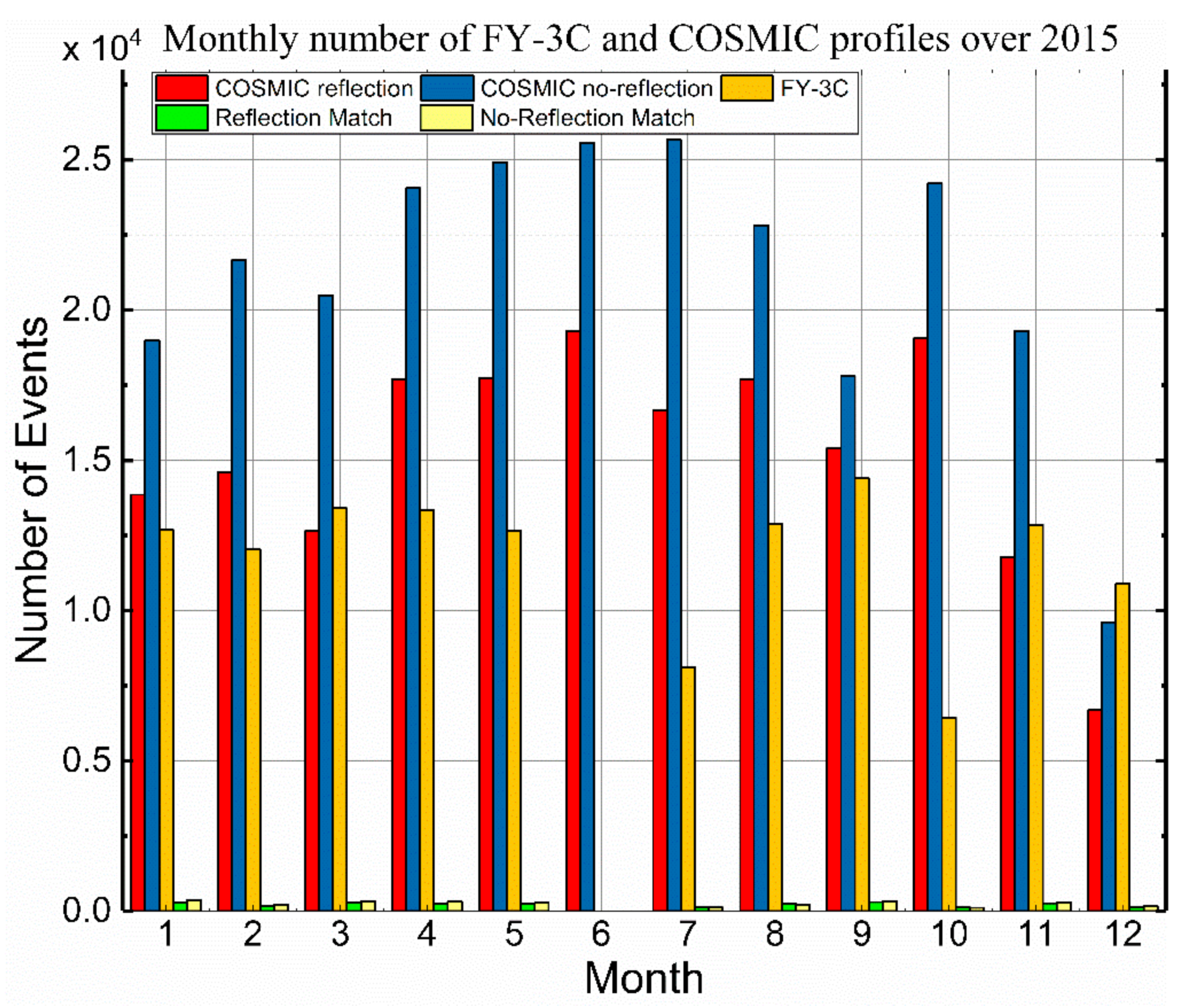
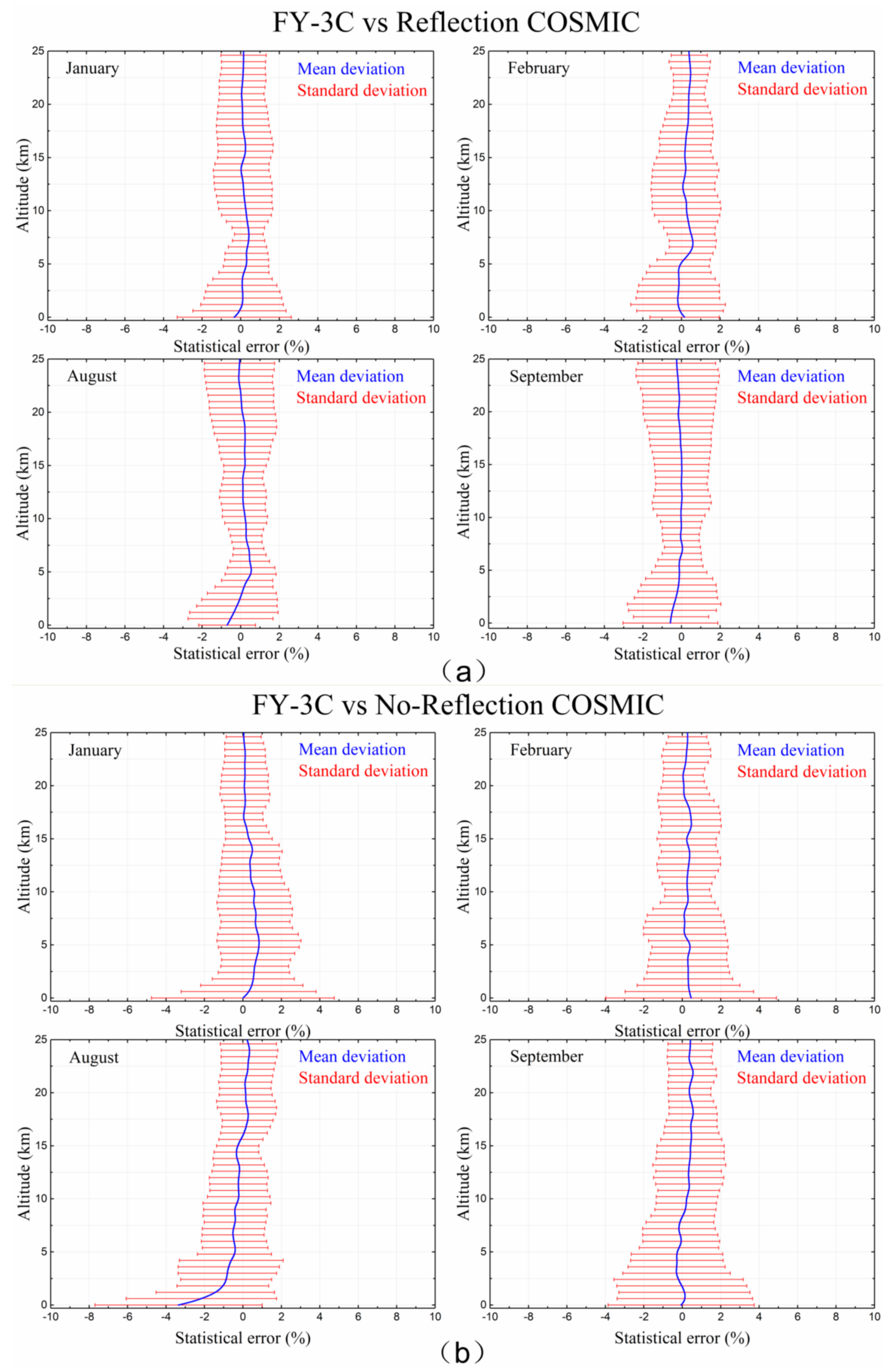
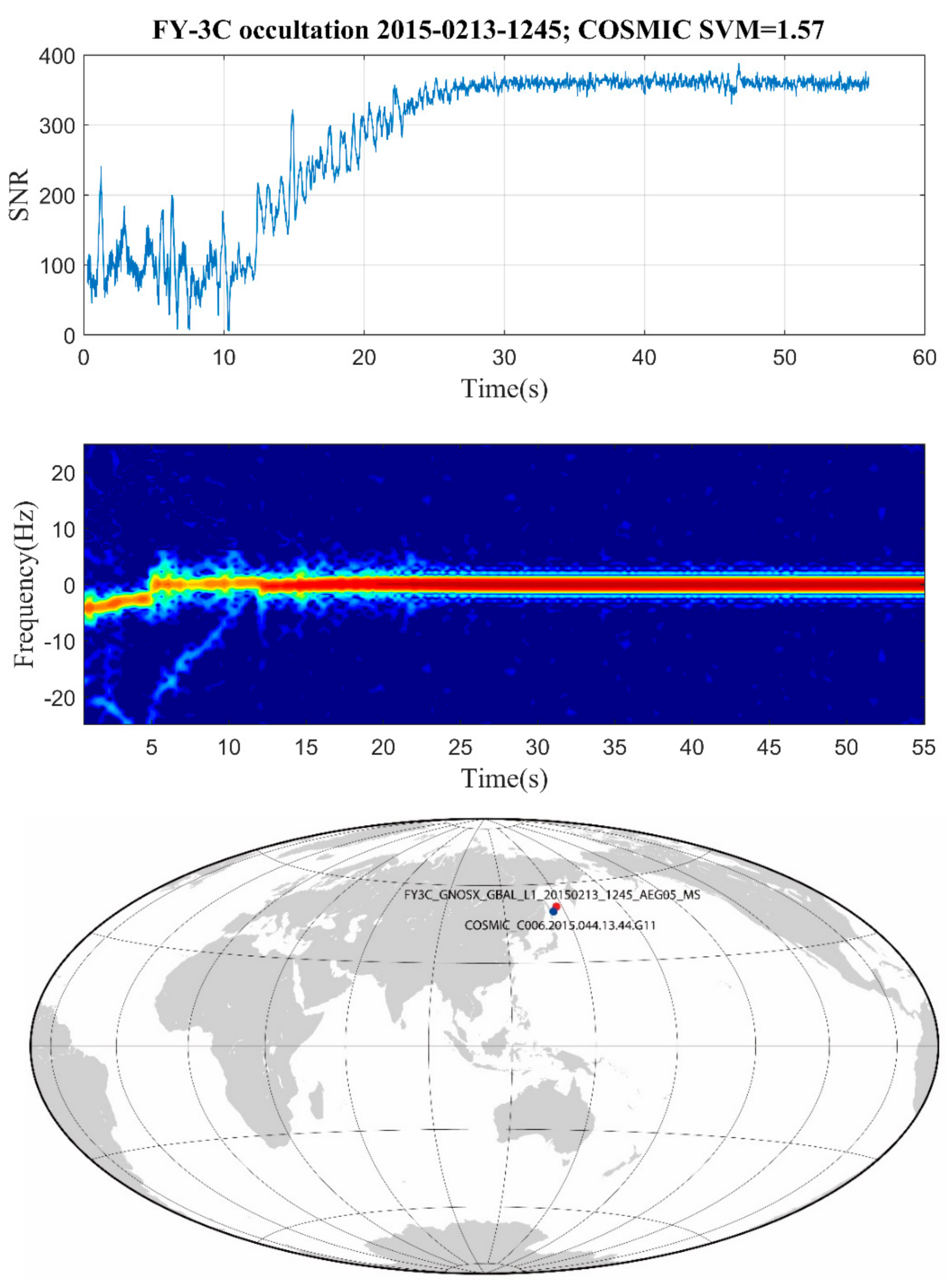
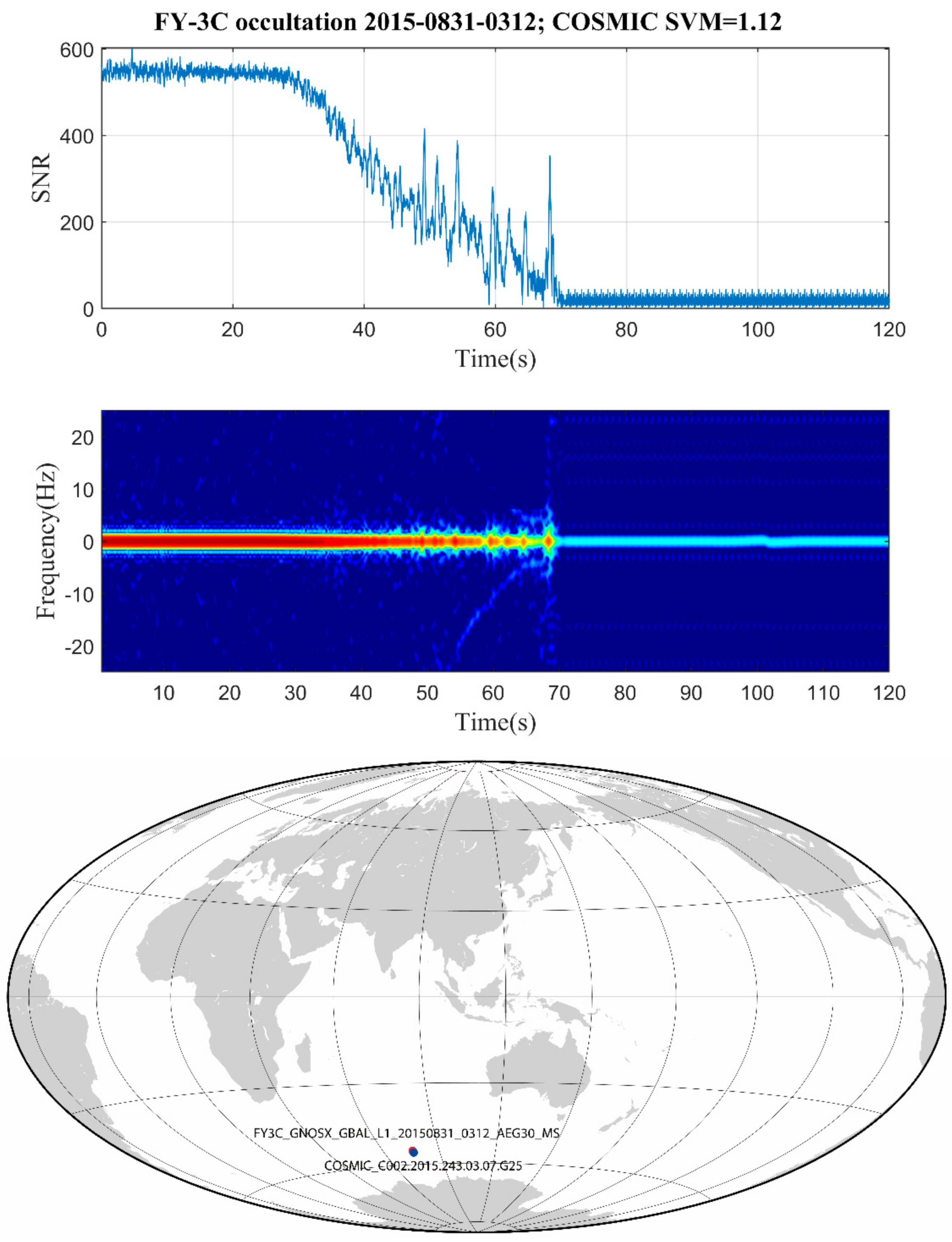
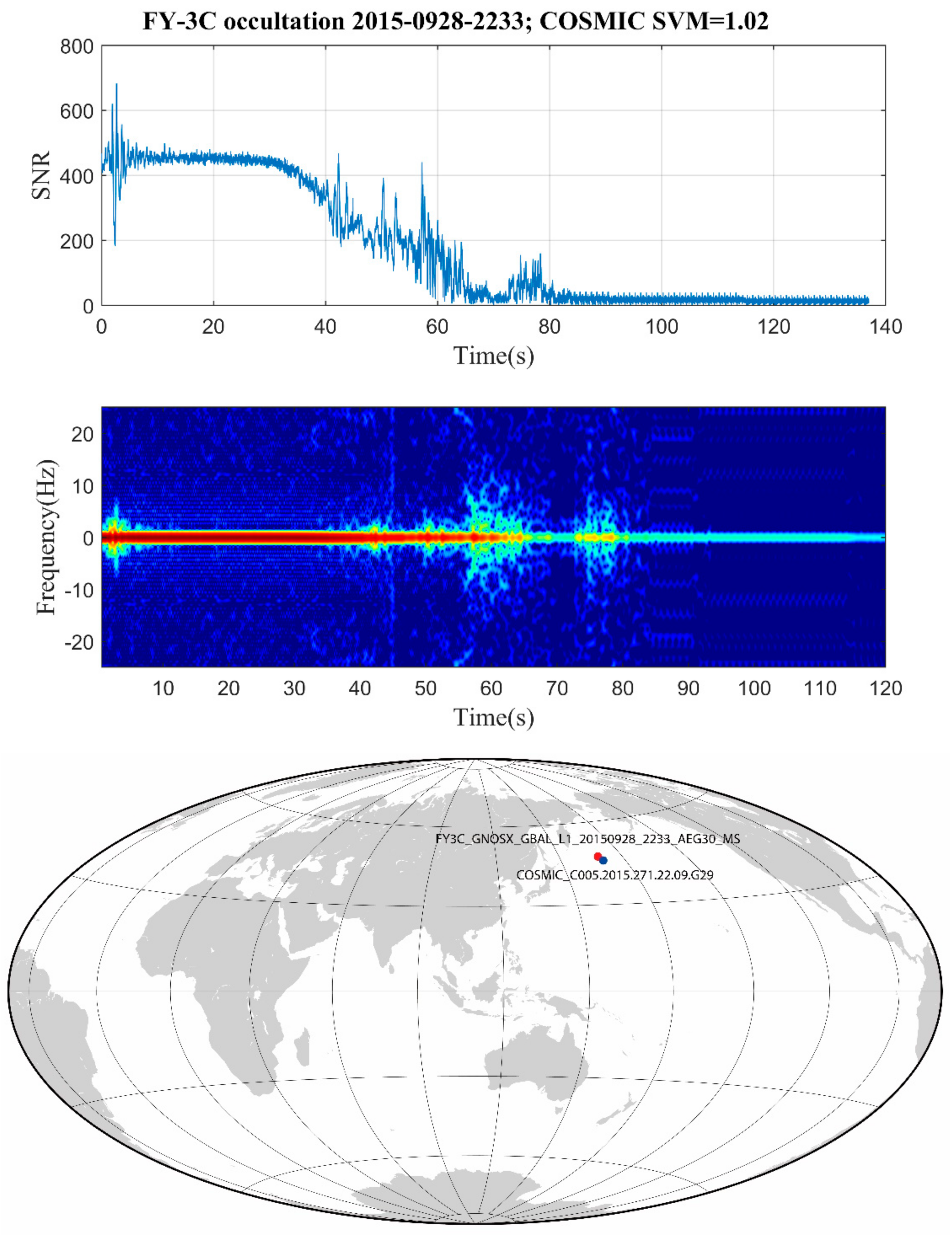

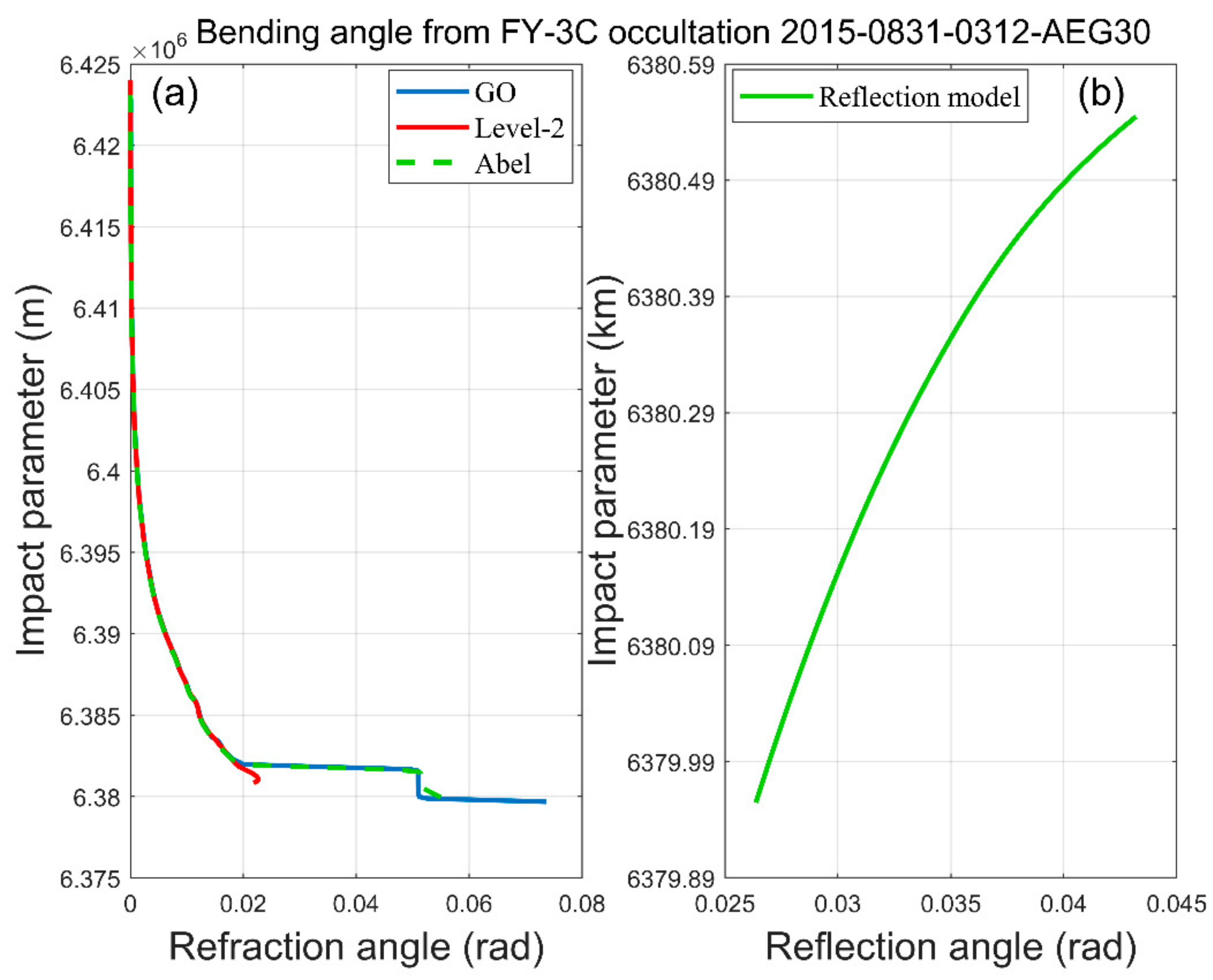
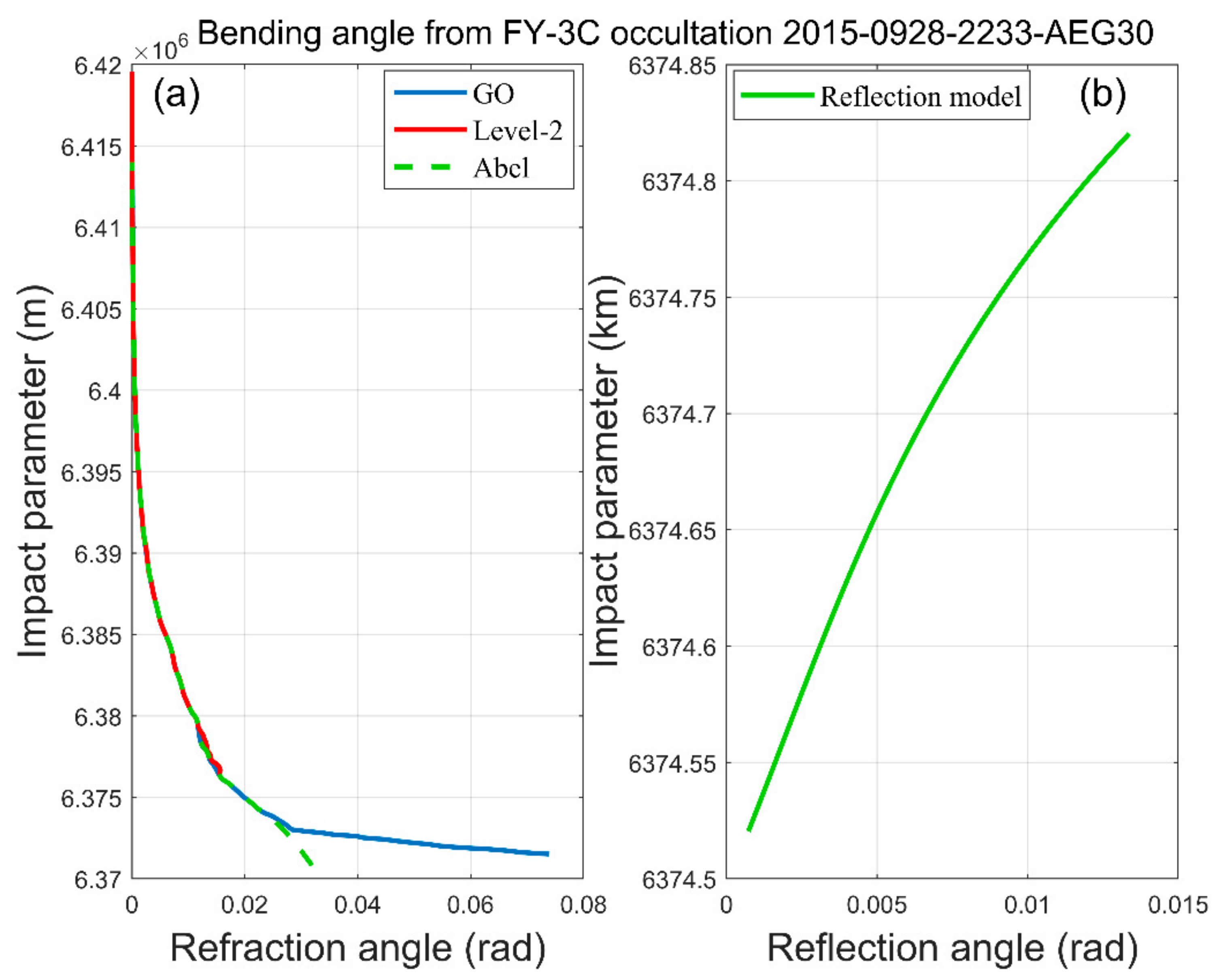
Publisher’s Note: MDPI stays neutral with regard to jurisdictional claims in published maps and institutional affiliations. |
© 2021 by the authors. Licensee MDPI, Basel, Switzerland. This article is an open access article distributed under the terms and conditions of the Creative Commons Attribution (CC BY) license (https://creativecommons.org/licenses/by/4.0/).
Share and Cite
Chen, W.; Xiong, Y.; Li, X.; Zhao, B.; Zhang, R.; Xu, S. Preliminary Validation of Surface Reflections from Fengyun-3C Radio Occultation Data. Remote Sens. 2021, 13, 1980. https://doi.org/10.3390/rs13101980
Chen W, Xiong Y, Li X, Zhao B, Zhang R, Xu S. Preliminary Validation of Surface Reflections from Fengyun-3C Radio Occultation Data. Remote Sensing. 2021; 13(10):1980. https://doi.org/10.3390/rs13101980
Chicago/Turabian StyleChen, Weiwei, Yongliang Xiong, Xinzhong Li, Ban Zhao, Rui Zhang, and Shaoguang Xu. 2021. "Preliminary Validation of Surface Reflections from Fengyun-3C Radio Occultation Data" Remote Sensing 13, no. 10: 1980. https://doi.org/10.3390/rs13101980
APA StyleChen, W., Xiong, Y., Li, X., Zhao, B., Zhang, R., & Xu, S. (2021). Preliminary Validation of Surface Reflections from Fengyun-3C Radio Occultation Data. Remote Sensing, 13(10), 1980. https://doi.org/10.3390/rs13101980






